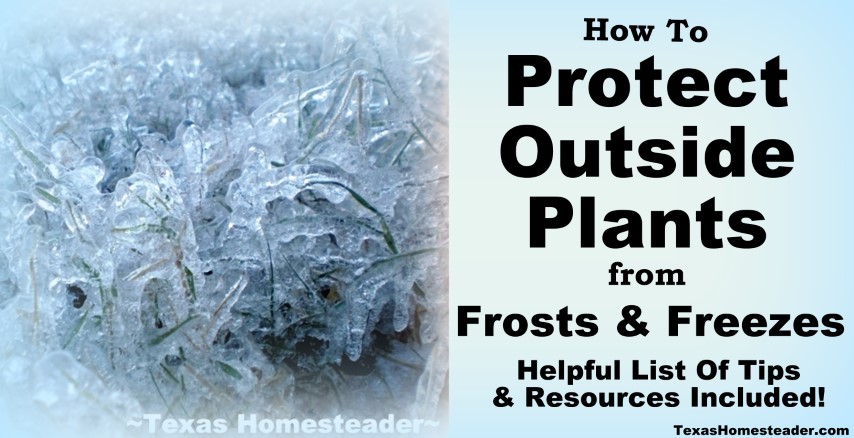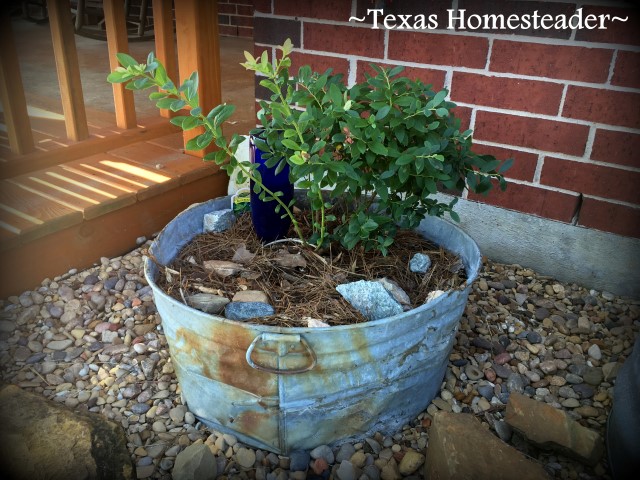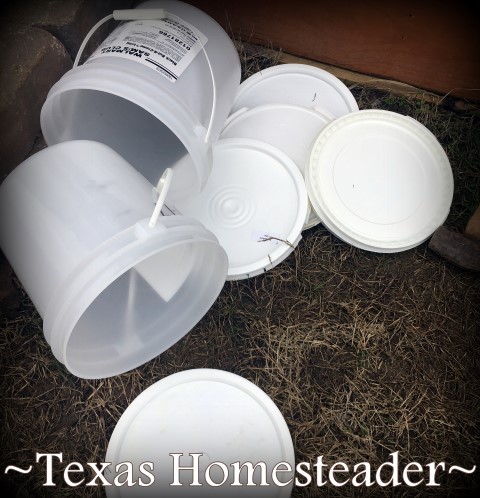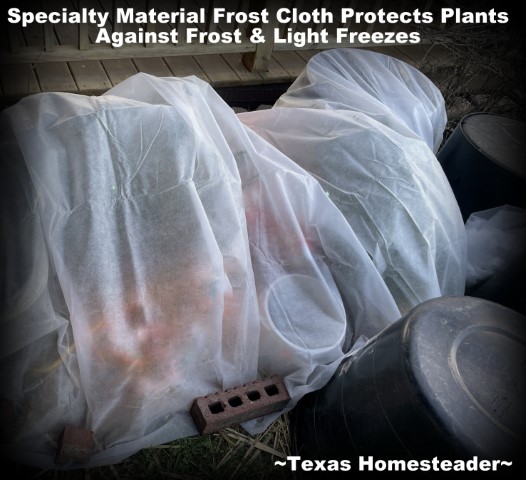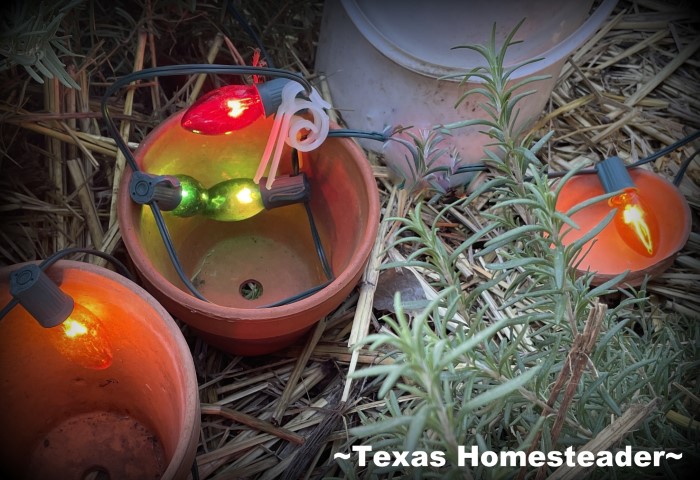by Texas Homesteader ~
When the weatherman says cold weather is coming, how do you protect your outside plants from frost or freeze?
I’m sharing a list of helpful tips & resources too. Check it out, y’all!
(Note: Some links in this post will take you to other related articles for further information. But links preceded with * are affiliate links. If you click and buy something I could receive a tiny commission.)
Protecting Outside Plants From Frost Or Freeze
The obvious first line of attack – if at all possible, bring sensitive potted plants inside when temperatures are forecast to plummet. It’s best to place them close to a sunny window.
It’s also good to know what plants may be toxic and make sure to keep those plants away from pets and children.
Another option is to place potted plants in a garage as long as the temperatures in your garage will stay above freezing.
What About Plants You Can’t Bring Inside?
If you don’t have enough room to bring all your potted plants inside and temps won’t dip severely you can place them on a covered porch close to your home. Warmth from your home helps keep your plants a few degrees warmer and you may get some of the wind blocked too.
Which Way Should Porch Face? Here on NE Texas the a south-facing porch is better than a north-facing one since the sun moves toward the southern sky in winter months. That means there will be some warming sun exposure on a south-facing porch that won’t be present on a north-facing porch.
Preparing Outside Plants For Cold Weather
But how to you prepare your outside plants, shrubs and trees for cold weather?
According to Texas A&M University (references at the bottom of this post) there are some important things you can do to prepare plants for cold weather.
Water Deeply The Day Before A Freeze – Plants that are well hydrated stand a better chance of withstanding cold weather. I always water plants deeply the day before a freeze and again a few hours before the freeze happens.
Insulate Plant’s Root Zone – Add a 2-4 inch blanket of hay, leaves or mulch to the plant’s root zone for insulation from the cold.
Offer Natural Ground Heat To Plants – You can cover plants to allow the natural heat from the ground to keep the plant warmer. (Various covering suggestions are offered below).
Add A Container Of Water – Water absorbs heat and releases it slowly. So I always place one or two plastic gallon buckets of water near my plant.
Wind Blocks – It’s good to block the coldest wind from your plants. I use large overturned buckets. But you can use anything to block the wind such as a wheelbarrow, picnic table tipped on its side, etc.
Why Does Covering Plants Protect Them From Frost?
Covering your plants when a frost or light freeze is expected accomplishes two important things:
Covering helps keep frost from forming on the leaves of your plants.
Covering allows natural heat from the ground to radiate up & warm your plant.
Coverings should not be limited to the plant itself but should tent over the entire plant including the root zone. Make sure to weight down the cover with rocks or ground staples to trap in the ground’s heat beneath the cover.
You’ll want to cover your plants as soon as the temperatures begin dropping and uncover them again when temps warm above freezing to allow the ground to warm again. Recover if another freeze is expected the next night.
How To Elevate Coverings Over Plants In Cold Weather
It’s best to not allow plant-covering material to touch the foliage during a frost or freeze. Here are some ways to elevate the coverings:
Wire Hoops – Can use field fencing made into a hoop
Patio chairs or folding chairs to drape cover over
We use *Push-In Hotwire Posts and drape frost cover over them
What Type Of Cover Helps Protect Plants From Frost?
According to Texas A&M University, there are many options when it comes to covering plants to protect them from cold weather.
It’s important to cover them including their root zone as opposed to just covering a plant from the stalk up. It’s the heat from the ground that keeps your plants warm!
*Frost Cloth Covers – You can buy a specially-made cloth made of spun polypropylene which offers insulation & breathability. They are most effective with frost and light freezes. (Deeper freezes are a challenge for any cover, even those specifically made for cold protection)
Sheets, Blankets, Towels – If you don’t have a frost cover, lightweight sheets, blankets or towels will help some.
Cardboard Boxes, Trash Cans – According to Texas A&M, you can use cardboard boxes or trash cans to cover sensitive plants to protect them from frosts and light freezes. I like to add an insulating layer inside a cardboard box for my thyme by adding wadded newspaper or straw between the inside of the box and my plant.
What about Using Plastic For Covering Plants To Protect From Cold? Plastic sheeting can be used in an emergency but it’s often not recommended to use plastic to protect plants from the cold. If you must use it make sure plastic does not touch the plant’s leaves and be extra sure to remove the plastic as soon as temperatures rise above freezing to keep it from actually damaging your plants.
Adding A Heat Source For Your Outside Plants
If you have access to electricity close by you can add a heat source for your outside plants and trees.
According to Texas A&M you can use *Large Outdoor Incandescent Christmas Lights (ie: NOT LED lights) to offer heat to plants.
I’ve done this and found it helpful. The bulbs do get hot so I don’t like to put the lights on the plants or trees themselves, although some people do.
Since heat rises I lay my incandescent Christmas lights around my plants beneath my frost coverings. I make sure to keep the lights away from anything flammable by placing the actual bulbs off the ground inside clay pots or on saucers or bricks and away from the frost cloth and dry straw.
I found even in the coldest weather, adding the Christmas lights beneath my frost cover kept the temperatures next to my plants 7-10 degrees warmer than outside the cover.
Some people add actual heat cables such as a *Roof De-Icing Cable or even a *Garden Soil Heating Cable.
Whatever you decide to use for heat, be aware of how much heat will be transmitted from the surface to avoid plant damage. And above all else – practice fire safety! Keep all flammables far away from heat sources or electrical plugs!
Thermostatically-Controlled Electric Plug
Since I use a heat source for my plants I have it plugged into a *Thermostatically-Controlled Electric Plug-In Outlet. This is so helpful – they turn on and off when targeted temperatures are reached! Mine automatically turns on when temperatures reach 35ºF and turns back off when the temperatures rise to 45ºF.
Monitoring Temperatures Next To Your Plants In Cold Weather
I like to monitor the temps beneath the frost cover. So I use a *Govee Wifi Bluetooth thermometer to track the current ground temps from the app on my cell phone. The thermometer is placed right at the base of my plant.
I hope this list of tips has been helpful for you to protect your plants. Happy gardening y’all!
~TxH~
Other Preparedness Posts
Electrical Power
- How To Stay Warm When The Power Goes Out
- How To Prepare For An Electrical Outage Emergency
- Temporary Power In An Emergency Electric Outage
Collecting Water
Food & Cooking
Underground Storm Shelter
- Safety From The Storm: Underground Storm Shelter
- What To Stock In Our Underground Storm Shelter
- Spring Maintenance Tips For A Storm Shelter
Other
Our Weather-Related Preparedness Posts
C’mon by & sit a spell! Come hang out at our Facebook Page. It’s like sitting in a front porch rocker with a glass of cold iced tea. Lots of good folks sharing! You can also follow along on Pinterest, on Twitter or on Instagram.
If you’d like to receive an email each time a new blog post goes live it’s EASY to
subscribe to our blog
References
Texas A&M University – Preparing Plants For Cold Weather
Iowa State University – Protect Plants From Frost & Freeze

